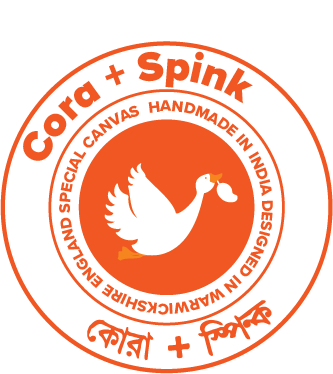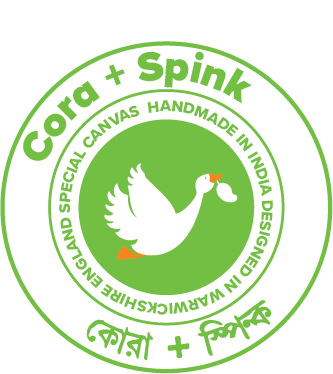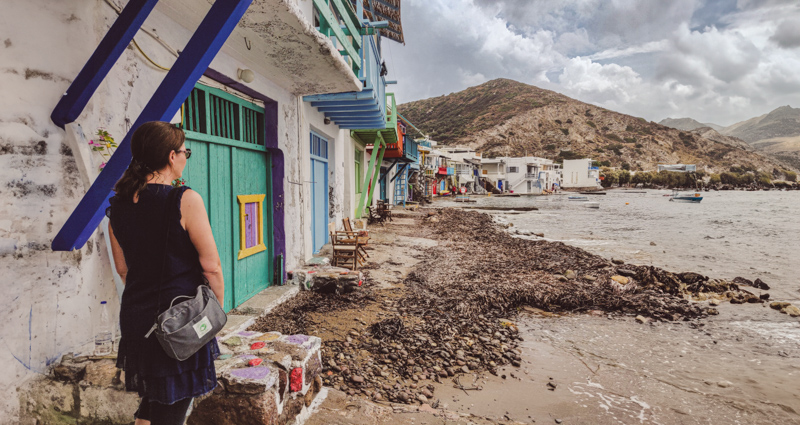The Complex World of PFAs: What are PFAs and why has Cora + Spink stopped using them?
What have frying pans got to do with Waterproof Backpacks?
What are PFAs and why are they problematic?
Frying pans, and waterproofed textiles have used the same set of chemicals known as Per and Polyfluoroalkyl substances for a long time. Invented in the 1930’s PFA’s are a range of synthetic chemicals that repel water and oil, a wonder from day one… that is, until it was discovered that their molecular stability makes them incredibly persistent, earning them the nickname “forever chemicals”.
The environmental toll.
PFAs just don’t disappear; they accumulate in water systems, soil, and living organisms. They are a set of inert synthetic molecules that have been found in and on every part of the globe. Much like (micro) plastic pollution, global persistent chemical, “forever chemical” contamination is a problem caused by their brilliance.
Contamination happens in a two main ways.
Firstly, and in the most significant quantities, spills and accidents at source through a variety of factors, but poor environmental control and protection procedures are usually blamed. See below for the USA map of PFA Contamination..
Secondly, daily use. Similar to micro plastic contamination, washing and laundry erodes the PFAs from the surface of the items being washed (used), releasing PFA’s in to the environment via waste water. Whilst recycling and disposal to landfill contributes is a common direct route.
Map: ewg.org – showing documented PFA contamination across the USA – 17th of August 2023.
Summary so far.
-
Environmental Impact: PFAs do not break down easily and contaminate water sources, affecting both wildlife and human populations.
-
Health Concerns: Studies have shown that PFAs affect growth and development, reproduction, and the immune system of biological systems in both plants, animals and humans.
C8 and C6 PFA – what the?
C8 PFA:
- Full Name: Perfluorooctanoic Acid (PFOA)
- Carbon Atoms: 8
- Environmental Impact: Highly persistent, bioaccumulative, and linked to adverse health effects.
- Usage: Traditionally used for water and stain resistance.
C6 PFA:
- Full Name: Perfluorohexanoic Acid (PFHxA)
- Carbon Atoms: 6
- Environmental Impact: Less persistent and bioaccumulative compared to C8, but still not entirely safe.
- Usage: Considered a “short-chain” alternative to C8 for similar applications.
Cora + Spink and PFA’s
In collaboration with our textile finisher near Delhi and their partnership with a specialized Japanese textile treatment company, we’ve been tackling one of the most challenging aspects of canvas production: waterproofing.
For years, the textile industry has been grappling with the environmental and health impacts of using PFAs for waterproofing. At C + S, we’ve been no exception. Despite exploring hundreds of textile mills and finishing companies globally, the options for making our natural cotton canvas waterproof—without resorting to PFAs or synthetic materials—were frustratingly limited. That’s why, for the last four years, we’ve been using a C6 PFA as a transitional solution.
While C6 is a step away from the more harmful C8 PFAs, it’s crucial to clarify that it’s not entirely devoid of environmental or health concerns. We’ve never used C8 technology, but many companies still do. So, whenever you see claims of ‘waterproof,’ it’s worth investigating what process that company uses.
The Future: A PFA Free C + S.
If you’ve made it this far, you’re probably wondering, “what’s next?” Well, by the end of 2024, all Cora + Spink products will be PFA free. As of today we’re in the final stages of testing a totally new waterproofing solution that will entirely replace PFAs. Achieving this is no small feat, however, like frying an egg perfectly in a polished steel frying pan instead of a non-stick one, it requires a bit of practice, but works out better in the end.
Our upcoming waterproofing solution aims to be as simple and environmentally sustainable as possible. Like every stage of our production, it’s subject to ongoing scrutiny and is likely to evolve over time. This article will be updated when we’re closer to launch.
Ideas, Questions, Suggestions
The best solutions always come from working together. That’s why we’re not just asking for your support; we’re inviting you to join us on this journey. If you have ideas, questions, or suggestions on how we can improve, innovate, or collaborate, we want to hear from you. Your insights are invaluable to us, and the more we can learn, the better we can become. If you work for or own a business we’re here to work together, and certainly have a chat!
So don’t hesitate to reach out to us directly here: Contact us directly.
Some interesting articles here that helped me write some of the science:
The Devil they Knew: Chemical Documents Analysis of Industry Influence on PFAS Science.
This article evaluates industry documents on PFAS and compares them to the public health literature. It shows that companies knew PFAS was “highly toxic when inhaled and moderately toxic when ingested” by 1970, forty years before the public health community. Read more on: nih.gov
The True Cost of PFAS and the Benefits of Acting Now.
This article discusses the true costs of PFAS, highlighting the need to act now to ensure that exposures are capped at current levels by reducing the production and use of PFAS. Read more on: nih.gov




New colour --- In the Navy - a deep navy blue, with strong indigo undertones - in Vyn, Tiger and Poly. Full production YAY OR NAY?
Adventures with @matoutea in @hudsons_stratford - is it a French ashtray, a pestle and mortar or an aioli mixing bowl??? #navy #antiques #stratford #dayout #tigerbum #bumbag
Berlin`s alArt, just outside the city in #Teufelsberg - for international women`s day. With @dom_fox and @annaeosborne #berlin #germany #bumbag
We found the car... Pondering what New Street Station has become... #midnight #train #photography #nightphotography #streetphotography #architecture
Stratford-upon-Avon. Just behind us is "Vish`s bridge", named as such after he dropped a brand new phone in the river taking a shot not dissimilar to this one. #stratford #river #magnetfishing #photography #tigerbum